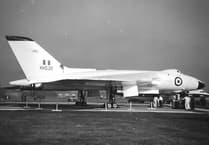Up until the middle of the 19th Century, Japan had isolated herself from the rest of the world. Then came the realisation that China and Russia both had steam navies and there was a fear that one or both would invade Japan. Japan was still a feudal state with no industry or a navy to meet this perceived threat.
Thus Japanese government asked Britain, the nation with the most powerful navy in the world at that time, to build a navy and train Japanese sailors to crew the new ships. Thus three ships were ordered in Britain. One of them, the Hiei, was built in the little Jacobs Pill shipyard in Bufferland,Pembroke Dock.
Sons of Samurai were sent to the Royal Naval College,at the time in Greenwich, London. to be trained as officers in the new Imperial Japanese Navy. One of them, Heihachiro Togo, qualified as a Lieutenant and was sent to Pembroke Dock to help in the construction of Hiei, a 2200-ton armoured Corvette built of iron and armed with 120mm and 150mm Krupps guns, 25mm Nordenfeldt machine guns and 450mm torpedos.
While in Pembroke Dock, he lived in the Master Shipwright’s House in the Royal Dockyard. The ship was launched on June 9, 1877, with great ceremony and Lt. Togo sailed off to Japan under the command of a Royal Navy captain.
On arrival in Japan, he sent a gingko sapling back to Pembroke Dock with the request
“Please plant this tree in the garden of my lodging house in appreciation of the kindnesses shown me during my stay in Pembroke Dock.”
His Excellency Uyeno Kagenori, Ambassador of Japan and Minister Plenipotentiary to the Mikado, to the United Kingdom performed the ceremony in 1878.
The tree flourished and was almost forgotten until David James started campaigning to rebuild a memorial over the grave of 10 Japanese sailors buried in Angle churchyard. This brought him into contact with Japanese dignitaries, businessmen and journalists. He told them the tale of the tree and took them to see it. They were very impressed and explained that Lt. Togo had risen to become Japan’s most famous Admiral and had defeated the Chinese navy in 1895 and totally destroyed the Russian Baltic fleet at the Battle of Tsusima in 1905, thus ensuring Japan could not be invaded.
He became Japan’s national hero, known as the Nelson of the East.
David was exhorted to take a cutting from this very special tree and it would be taken to Japan to be planted in a place of honour in remembrance of Admiral Togo.
Horticulturalists from the National Botanic Gardens of Wales took many cuttings and potted them on in their greenhouses until they were strong enough to be exported to Japan. The Embassy of Japan became very interested and suggested that saplings should be planted in all the sites in Japan that were associated with Admiral Togo, some 15 in all. The saplings were flown to Japan and arrived at the Hiroshima Botanic Gardens on Christmas Eve 2019 for a period of quarantine.
The saplings thrived and sprouted leaves in the spring and the first ceremonial planting was held at the Naval Base at Kure City.
It is fitting that a sapling grown from a cutting taken from a house that Admiral Togo once lived in at a Royal Dockyard in Pembroke Dock has been planted at another house that he once lived in at Kure Naval Base in Japan.
David James, who lives in Cosheston, is an historian specialising in the maritime history and heritage of Wales generally and Pembrokeshire in particular
For actively promoting relations between Japan and the United Kingdom, he was awarded a Certificate of Commendation by the Japanese Ambassador to the UK. The certificate is in Japanese, but translated, it reads:
The Ambassador of Japan extends his deepest regards to Mr. David James in recognition of his distinguished contribution to the deepening of mutual understanding and friendship between Japan and the United Kingsom. Awarded on December 6th, 2019, in London.
Ambassador of Japan to the United Kingdom, H. E. Mr. Yasumasa Nagamine.





Comments
This article has no comments yet. Be the first to leave a comment.